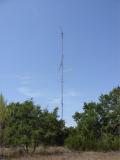 |
This is the "forty meter" tower. George has five towers, and they all
have a variety of antennas on them, but I tend to think of them by the
band of the monobander antenna at the top of the tower. This tower is
120 feet of Rohn 45G. The top antenna is a Force 12 240N. below it is a
six-element monobander for 20 meters on a 44 foot long boom fixed northeast
about 80 feet above ground. The small antenna below it is some sort of
WARC band antenna for PACTOR. This tower also has two 80 meter sloping
dipoles and two 160 meter sloping dipoles hanging from it.
|
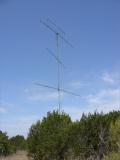 |
This is the "twenty meter" tower, although it actually has a two-element
Cushcraft 40 meter monobander at the very top of the mast, above a six-element
monobander for 20 meters built on a 44 foot long boom. The tower is 80 feet
of Rohn 45G. A four-element Cushcraft monobander for 20 meters at 60 feet
above ground is fixed to the southeast. Below that, another six-element
monobander for 20 meters built on a 44 foot long boom is fixed northwest
at 40 feet above ground.
|
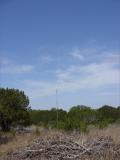 |
This is an elevated vertical dipole for 10 meters that I sometimes
find useful in the ARRL 10 Meter Contest.
|
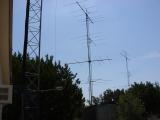 |
From left to right: the "VHF tower" next to the house, the "ten meter"
tower, and the "fifteen meter" tower.
|
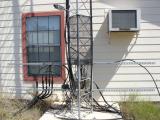 |
The "VHF tower" is a 30 foot tall self-supporting Rohn 45G tower next
to the radio shack. Coax and control cables from the other towers
arrive here before they enter the building at the aluminum panel to the
bottom right of the window.
|
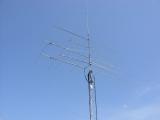 |
The "VHF tower" has a pair of single-band Yagis for 432 MHz, and single
Yagis for 222 MHz, 144 MHz, and 50 MHz. At the top of the tower is a
two meter vertical.
|
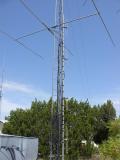 |
On the side of the 10 meter tower, George has a vertical array of folded
dipoles for 144 MHz. The vertical array has more gain than a typical
vertical, and is sometimes useful in contests because of its vertical
polarization.
|
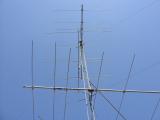 |
The "fifteen meter" tower is 70 feet of Rohn 25G. At the very top is a long
boom Yagi for 50 MHz. Also on the mast, at 70 feet above ground, is a 15
meter Yagi on a 36 foot boom. A four-element Cushcraft monobander for 15
meters is fixed southeast at 50 feet above ground. A six-element Yagi for
50 MHz is fixed to the west at 40 feet above ground. A second 15
meter Yagi on a 36 foot boom is fixed northeast at 30 feet above ground.
|
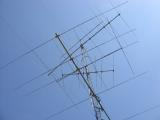 |
The "ten meter" tower (60 feet of Rohn 25G) is also complicated. At the very
top, 65 feet above ground, is an eight-element Yagi for 144 MHz. Also on the
mast is a 10 meter Yagi on a 24 foot boom at 60 feet above ground. At 45
feet above ground is a four-element Cushcraft monobander fixed southeast.
Another 10 meter Yagi on a 24 foot boom is fixed northeast at 30 feet above
ground. Just 20 feet above grond is a three-element 10 meter Yagi fixed to
the west.
|
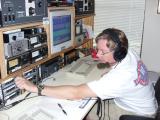 |
Robert K5PI gets the right hand station checked out a few minutes before
the contest start.
|
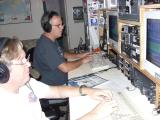 |
George K5TR (in the black shirt), operating on 20 meters and Robert K5PI (in
the white shirt) operating on 15 meters. Both stations were configured to
use one Elecraft K3 transceiver.
|
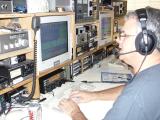 |
George K5TR on 14.225 MHz phone. The hand mic to the left of the monitor
belongs to a 144 MHz FM radio we use during VHF contests.
|
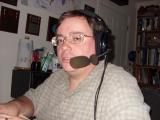 |
Ken WM5R, probably operating on 40 meters.
|
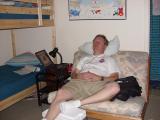 |
I'm not sure what music Robert was listening to during his off-time.
Probably bluegrass - which would explain why he fell asleep.
|
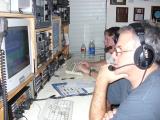 |
Operating late into the night. This contest is 12 hours long, from 1:00 PM
local time to 1:00 AM local time.
|
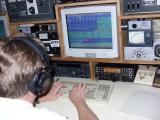 |
Five minutes to go!
|















